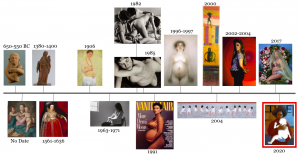
This exhibition investigates the history of pregnancy in art from 550 BC to the present. It is a product of Professor Fletcher’s Women, Gender, & Sexuality in Art History course taught at Bowdoin College and is grounded in works from the Bowdoin College Museum of Art. We, the curators of this exhibition, were instantly compelled to work within the subject of pregnancy. As five young women grappling all too often with conversations surrounding our bodies, these works aim to explore the history of a subject that continues to impact our own agency in reproduction. Our study is divided into five themes: Early Representations, Idealized vs. Realized depictions, The Portrayal of Birth, Women Representing Themselves, and Visibility and Intersectionality in the Contemporary World.
In our first theme, we explore the history of representing pregnant women through art. We encounter a small number of portrayals that go as far back as the stone age but largely, depictions of pregnancy and pregnant women are absent. In order to understand why this is the case, we investigate who created the few depictions we do have and the historical context in which they came to fruition.
The Idealized vs. Realized theme explores the relationship between images of pregnant women and their societal role. Earlier representations by men made pregnancy look beautiful and easy in order to preserve women’s role in stewarding new generations. More recently, women have begun to create art that displays the physical, emotional, and creative labor that women undertake in pregnancy in order to empower women with the right to choose pregnancy.
Another way that artists have investigated depictions of pregnancy is by documenting birth itself. We focus on two artists who each had a unique way to depict childbirth. The first created a photograph showing an at-home pregnancy. The photographer chose a position in which the mother’s face was hidden from view. The second had a live childbirth in a performance art exhibition. Although enduring the physical labor, viewers summed her performance to be “beautiful.” In both pieces, the agency and individuality promised to the mother is undermined by beauty standards and the male gaze.
In this third theme, we specifically explore pregnancy from a female perspective. In looking at how women artists took back their bodies beginning in the twentieth century, we can better understand the historical norms they are rejecting. Paula Modersohn-Becker spurred this shift with power and truth, expressionistically painting her own body. This simple choice of subject and rejection of romantic features, encouraged modern women to depict their genuine experiences with motherhood. Following Becker, we witness undertakings by Anne Harris, Nancy Spero, and Xiuwen Cui— each offering a unique portrayal, proving an existence of a multitude of pregnancy narratives in art and the world.
The exhibition is bookended by exploring visibility and intersectionality in contemporary depictions of pregnant bodies. Using three of our most recently made and most widely published pieces in the exhibition, we can reflect on how the narrative of pregnancy has become celebrated and empowered as visibility of pregnant bodies has increased through social and mass media. At the same time, these pieces must be seen through a critical lens, acknowledging that this narrative can be idealized and exclusive.
As viewers, we want to offer you new perspectives on portrayals of pregnancy and reproduction so that you may venture forth and confront an image of a pregnant woman with a historical and critical lens. We hope that you might pause and reflect: Who created this image? For what audience? How does history impact its meaning? What narrative does this image share? And, are there gaps within this narrative?
Enjoy!
Sincerely,
Ana Gunther, Bianca Allende Boyd, Cloe Tarlton, Lexie Freund, Lizzy Gracey

